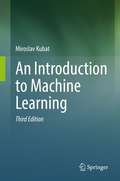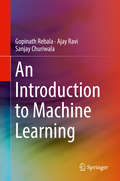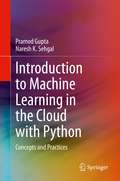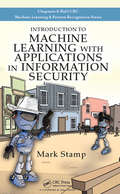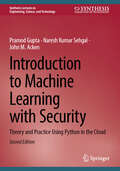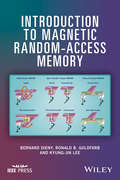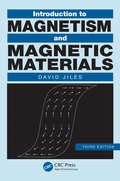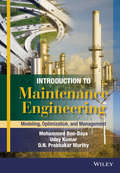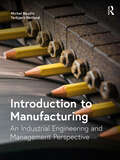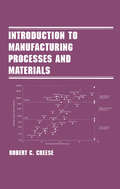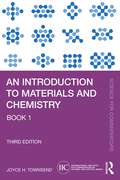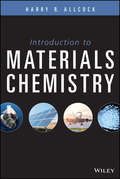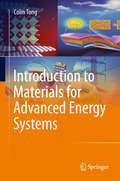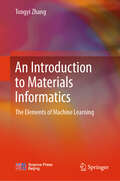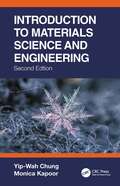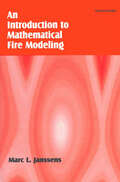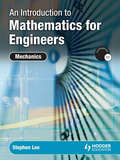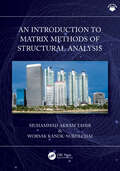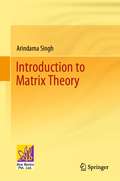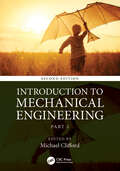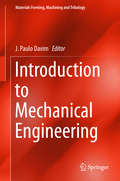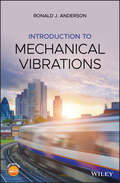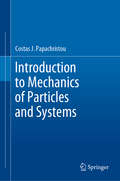- Table View
- List View
An Introduction to LTE: LTE, LTE-Advanced, SAE and 4G Mobile Communications
by Christopher CoxAn Introduction to LTE explains the technology used by 3GPP Long Term Evolution. The book covers the whole of LTE, both the techniques used for radio communication between the base station and the mobile phone, and the techniques used for signalling communication and data transport in the evolved packet core. It avoids unnecessary detail, focussing instead on conveying a sound understanding of the entire system. The book is aimed at mobile telecommunication professionals, who want to understand what LTE is and how it works. It is invaluable for engineers who are working on LTE, notably those who are transferring from other technologies such as UMTS and cdma2000, those who are experts in one part of LTE but who want to understand the system as a whole, and those who are new to mobile telecommunications altogether. It is also relevant to those working in non technical roles, such as project managers, marketing executives and intellectual property consultants. On completing the book, the reader will have a clear understanding of LTE, and will be able to tackle the more specialised books and the 3GPP specifications with confidence. Key features - Covers the latest developments in release 10 of the 3GPP specifications, including the new capabilities of LTE-Advanced Includes references to individual sections of the 3GPP specifications, to help readers understand the principles of each topic before going to the specifications for more detailed information Requires no previous knowledge of mobile telecommunications, or of the mathematical techniques that LTE uses for radio transmission and reception
An Introduction to Machine Learning
by Miroslav KubatThis textbook offers a comprehensive introduction to Machine Learning techniques and algorithms. This Third Edition covers newer approaches that have become highly topical, including deep learning, and auto-encoding, introductory information about temporal learning and hidden Markov models, and a much more detailed treatment of reinforcement learning. The book is written in an easy-to-understand manner with many examples and pictures, and with a lot of practical advice and discussions of simple applications. The main topics include Bayesian classifiers, nearest-neighbor classifiers, linear and polynomial classifiers, decision trees, rule-induction programs, artificial neural networks, support vector machines, boosting algorithms, unsupervised learning (including Kohonen networks and auto-encoding), deep learning, reinforcement learning, temporal learning (including long short-term memory), hidden Markov models, and the genetic algorithm. Special attention is devoted to performance evaluation, statistical assessment, and to many practical issues ranging from feature selection and feature construction to bias, context, multi-label domains, and the problem of imbalanced classes.
An Introduction to Machine Learning
by Gopinath Rebala Ajay Ravi Sanjay ChuriwalaJust like electricity, Machine Learning will revolutionize our life in many ways – some of which are not even conceivable today. This book provides a thorough conceptual understanding of Machine Learning techniques and algorithms. Many of the mathematical concepts are explained in an intuitive manner. The book starts with an overview of machine learning and the underlying Mathematical and Statistical concepts before moving onto machine learning topics. It gradually builds up the depth, covering many of the present day machine learning algorithms, ending in Deep Learning and Reinforcement Learning algorithms. The book also covers some of the popular Machine Learning applications. The material in this book is agnostic to any specific programming language or hardware so that readers can try these concepts on whichever platforms they are already familiar with. Offers a comprehensive introduction to Machine Learning, while not assuming any prior knowledge of the topic;Provides a complete overview of available techniques and algorithms in conceptual terms, covering various application domains of machine learning;Not tied to any specific software language or hardware implementation.
Introduction to Machine Learning in the Cloud with Python: Concepts and Practices
by Pramod Gupta Naresh K. SehgalThis book provides an introduction to machine learning and cloud computing, both from a conceptual level, along with their usage with underlying infrastructure. The authors emphasize fundamentals and best practices for using AI and ML in a dynamic infrastructure with cloud computing and high security, preparing readers to select and make use of appropriate techniques. Important topics are demonstrated using real applications and case studies.
Introduction to Machine Learning with Applications in Information Security
by Mark Stamp<p>Introduction to Machine Learning with Applications in Information Security provides a class-tested introduction to a wide variety of machine learning algorithms, reinforced through realistic applications. The book is accessible and doesn’t prove theorems, or otherwise dwell on mathematical theory. The goal is to present topics at an intuitive level, with just enough detail to clarify the underlying concepts. <p>The book covers core machine learning topics in-depth, including Hidden Markov Models, Principal Component Analysis, Support Vector Machines, and Clustering. It also includes coverage of Nearest Neighbors, Neural Networks, Boosting and AdaBoost, Random Forests, Linear Discriminant Analysis, Vector Quantization, Naive Bayes, Regression Analysis, Conditional Random Fields, and Data Analysis. <p>Most of the examples in the book are drawn from the field of information security, with many of the machine learning applications specifically focused on malware. The applications presented are designed to demystify machine learning techniques by providing straightforward scenarios. Many of the exercises in this book require some programming, and basic computing concepts are assumed in a few of the application sections. However, anyone with a modest amount of programming experience should have no trouble with this aspect of the book. <p>Instructor resources, including PowerPoint slides, lecture videos, and other relevant material are provided on an accompanying website: http://www.cs.sjsu.edu/~stamp/ML/. For the reader’s benefit, the figures in the book are also available in electronic form, and in color.
Introduction to Machine Learning with Security: Theory and Practice Using Python in the Cloud (Synthesis Lectures on Engineering, Science, and Technology)
by Naresh Kumar Sehgal Pramod Gupta John M. AckenThis book provides an introduction to machine learning, security and cloud computing, from a conceptual level, along with their usage with underlying infrastructure. The authors emphasize fundamentals and best practices for using AI and ML in a dynamic infrastructure with cloud computing and high security, preparing readers to select and make use of appropriate techniques. Important topics are demonstrated using real applications and case studies.
Introduction to Magnetic Random-Access Memory
by Bernard Dieny Kyung-Jin Lee Ronald B. GoldfarbMagnetic random-access memory (MRAM) is poised to replace traditional computer memory based on complementary metal-oxide semiconductors (CMOS). MRAM will surpass all other types of memory devices in terms of nonvolatility, low energy dissipation, fast switching speed, radiation hardness, and durability. Although toggle-MRAM is currently a commercial product, it is clear that future developments in MRAM will be based on spin-transfer torque, which makes use of electrons' spin angular momentum instead of their charge. MRAM will require an amalgamation of magnetics and microelectronics technologies. However, researchers and developers in magnetics and in microelectronics attend different technical conferences, publish in different journals, use different tools, and have different backgrounds in condensed-matter physics, electrical engineering, and materials science. This book is an introduction to MRAM for microelectronics engineers written by specialists in magnetic materials and devices. It presents the basic phenomena involved in MRAM, the materials and film stacks being used, the basic principles of the various types of MRAM (toggle and spin-transfer torque; magnetized in-plane or perpendicular-to-plane), the back-end magnetic technology, and recent developments toward logic-in-memory architectures. It helps bridge the cultural gap between the microelectronics and magnetics communities.
Introduction to Magnetism and Magnetic Materials
by David JilesA long overdue update, this edition of Introduction to Magnetism and Magnetic Materials is a complete revision of its predecessor. While it provides relatively minor updates to the first two sections, the third section contains vast updates to reflect the enormous progress made in applications in the past 15 years, particularly in magnetic recordin
Introduction to Maintenance Engineering: Modelling, Optimization and Management
by Mohamed Ben-Daya D. N. Murthy Uday KumarThis introductory textbook links theory with practice using real illustrative cases involving products, plants and infrastructures and exposes the student to the evolutionary trends in maintenance. Provides an interdisciplinary approach which links, engineering, science, technology, mathematical modelling, data collection and analysis, economics and management Blends theory with practice illustrated through examples relating to products, plants and infrastructures Focuses on concepts, tools and techniques Identifies the special management requirements of various engineered objects (products, plants, and infrastructures)
Introduction to Manufacturing: An Industrial Engineering and Management Perspective
by Michel Baudin Torbjørn NetlandThis Introduction to Manufacturing focuses students on the issues that matter to practicing industrial engineers and managers. It offers a systems perspective on designing, managing, and improving manufacturing operations. On each topic, it covers the key issues, with pointers on where to dig deeper. Unlike the many textbooks on operations management, supply chain management, and process technology, this book weaves together these threads as they interact in manufacturing. It has five parts: Getting to Know Manufacturing: Fundamental concepts of manufacturing as an economic activity, from manufacturing strategy to forecasting market demand Engineering the Factory: Physical design of factories and processes, the necessary infrastructure and technology for manufacturing Making Information Flow: The "central nervous system" that triggers and responds to events occurring in production Making Materials Flow: The logistics of manufacturing, from materials handling inside the factory via warehousing to supply chain management Enhancing Performance: Managing manufacturing performance and methods to maintain and improve it, both in times of normal operations and emergencies Supported with rich illustrations and teaching aids, Introduction to Manufacturing is essential reading for industrial engineering and management students – of all ages and backgrounds – engaged in the vital task of making the things we all use.
Introduction to Manufacturing Processes and Materials (Manufacturing Engineering and Materials Processing #Vol. 54)
by Robert CreeseThe first manufacturing book to examine time-based break-even analysis, this landmark reference/text applies cost analysis to a variety of industrial processes, employing a new, problem-based approach to manufacturing procedures, materials, and management. An Introduction to Manufacturing Processes and Materials integrates analysis of material costs and process costs, yielding a realistic, effective approach to planning and executing efficient manufacturing schemes. It discusses tool engineering, particularly in terms of cost for press work, forming dies, and casting patterns, process parameters such as gating and riser design for casting, feeds, and more.
An Introduction to Materials and Chemistry: Book 1 (Science for Conservators)
by Joyce H. TownsendThis new edition of An Introduction to Materials and Chemistry, book 1 in the updated Science for Conservators series, provides conservators and conservators-in-training with a very basic introduction to the language of chemistry and to the scientific approach. Drawing on 40 years of experience as a conservation scientist, Joyce H. Townsend takes readers through the elementary steps that will enable them to understand and investigate materials in historic objects, and those modern materials used to conserve them, in scientific terms. The book also introduces basic chemistry concepts. It provides worked examples and exercises throughout. This new edition has been significantly expanded and updated, with new material about health and safety, sustainability, and the trend to use greener materials, amongst other topics. The book also includes all-new illustrations, a list of further reading and is accompanied by a Companion Website, which features additional examples, illustrations and more. An Introduction to Materials and Chemistry assumes no previous scientific knowledge and will be essential reading for pre-program applicants to, and students already on, postgraduate conservation programs worldwide. It will also be useful to conservators who are looking to refresh their knowledge or to fill gaps in their training, and for those who trained in languages other than English, but now work in that language.
Introduction to Materials Chemistry
by Harry R. AllcockThis textbook introduces the reader to the elementary chemistry on which materials science depends by discussing the different classes of materials and their applications. It shows the reader how different types of materials are produced, why they possess specific properties, and how they are used in technology. Each chapter contains study questions to enable discussions and consolidation of the acquired knowledge. The new edition of this textbook is completely revised and updated to reflect the significant expansion of the field of materials chemistry over the last years, covering now also topics such as graphene, nanotubes, light emitting diodes, extreme photolithography, biomedical materials, and metal organic frameworks. From the reviews of the first edition: "This book is not only informative and comprehensive for a novice reader, but also a valuable resource for a scientist and/or an industrialist for new and novel challenges." (Materials and Manufacturing Process, June 2009) "Allcock provides a clear path by first describing basic chemical principles, then distinguishing between the various major materials groups, and finally enriching the student by offering a variety of special examples." (CHOICE, April 2009) "Proceeding logically from the basics to materials in advanced technology, it covers the fundamentals of materials chemistry, including principles of materials synthesis and materials characterization methods." (Internationale Fachzeitschrift Metall, January 2009)
Introduction to Materials Chemistry
by Harry R. AllcockIntroduction to Materials Chemistry will appeal to advanced undergraduates and graduate students in chemistry, materials science,and chemical engineering by leading them stepwise from the elementary chemistry on which materials science depends, through a discussion of the different classes of materials, and ending with a description of how materials are used in devices and general technology.
Introduction to Materials for Advanced Energy Systems
by Colin TongThis first of its kind text enables today’s students to understand current and future energy challenges, to acquire skills for selecting and using materials and manufacturing processes in the design of energy systems, and to develop a cross-functional approach to materials, mechanics, electronics and processes of energy production. While taking economic and regulatory aspects into account, this textbook provides a comprehensive introduction to the range of materials used for advanced energy systems, including fossil, nuclear, solar, bio, wind, geothermal, ocean and hydropower, hydrogen, and nuclear, as well as thermal energy storage and electrochemical storage in fuel cells. A separate chapter is devoted to emerging energy harvesting systems. Integrated coverage includes the application of scientific and engineering principles to materials that enable different types of energy systems. Properties, performance, modeling, fabrication, characterization and application of structural, functional and hybrid materials are described for each energy system. Readers will appreciate the complex relationships among materials selection, optimizing design, and component operating conditions in each energy system. Research and development trends of novel emerging materials for future hybrid energy systems are also considered. Each chapter is basically a self-contained unit, easily enabling instructors to adapt the book for coursework. This textbook is suitable for students in science and engineering who seek to obtain a comprehensive understanding of different energy processes, and how materials enable energy harvesting, conversion, and storage. In setting forth the latest advances and new frontiers of research, the text also serves as a comprehensive reference on energy materials for experienced materials scientists, engineers, and physicists. Includes pedagogical features such as in-depth side bars, worked-out and end-of- chapter exercises, and many references to further reading Provides comprehensive coverage of materials-based solutions for major and emerging energy systems Brings together diverse subject matter by integrating theory with engaging insights
An Introduction to Materials Informatics: The Elements of Machine Learning
by Tongyi ZhangThis textbook educates current and future materials workers, engineers, and researchers on Materials Informatics. Volume I serves as an introduction, merging AI, ML, materials science, and engineering. It covers essential topics and algorithms in 11 chapters, including Linear Regression, Neural Networks, and more. Suitable for diverse fields like materials science, physics, and chemistry, it enables quick and easy learning of Materials Informatics for readers without prior AI and ML knowledge.
Introduction to Materials Science and Engineering
by Yip-Wah Chung Monica KapoorOur civilization owes its most significant milestones to our use of materials. Metals gave us better agriculture and eventually the industrial revolution, silicon gave us the digital revolution, and we’re just beginning to see what nanomaterials yield. Updated to reflect the many societal and technological changes in the field since publication of the first edition, Introduction to Materials Science and Engineering, Second Edition, offers an interdisciplinary view that emphasizes the importance of materials to engineering applications and builds the basis needed to select, modify, and create materials to meet specific criteria. The most outstanding feature of this book is the authors’ unique and engaging application-oriented approach. By beginning each chapter with a real-life example, an experiment, or interesting facts, the authors wield an expertly crafted treatment that entertains and motivates as much as informs and educates. The discipline is linked to modern developments, such as semiconductor devices, nanomaterials, and thin films, while working systematically from atomic bonding and analytical methods to crystalline, electronic, mechanical, and magnetic properties as well as ceramics, polymers, corrosion, and phase diagrams. Updates in the Second Edition References to advances in the field, including computational thermodynamics, allowing computation of phase diagrams with great accuracy and new materials Updated applications and technologies, such as electric vehicles and the use of magnetic fields as a processing tool Revised, practical end-of-chapter problems that go beyond traditional plug-and-chug exercises to enhance learning More examples with detailed solutions in each chapter A new chapter highlighting how materials can impact four United Nations Sustainable Development Goals This book is written for undergraduate students and readers interested in introductory materials science and engineering concepts. This concise textbook provides a strong foundation in materials science engineering and its applications. A solutions manual and PowerPoint lecture slides are available for adopting professors.
Introduction to Mathematical Fire Modeling
by Marc L. JanssensComputer simulation proves to be a valuable tool for the analysis and prediction of compartment fires. With the proper understanding and software, fire safety professionals can use modeling tools and methods to find answers to many critical questions relating to the prevention, investigation, and reconstruction of compartment fires.Thorough
An Introduction to Mathematics for Engineers: Mechanics
by Stephen LeeThis new introductory mechanics textbook is written for engineering students within further and higher education who are looking to bridge the gap between A-Level and university or college.
An Introduction to Matrix Methods of Structural Analysis
by Muhammad Akram Tahir Worsak Kanok-NukulchaiThe matrix force method has been systematically developed for the analysis of beam and frame structures. It helps develop the matrix stiffness method from a basic spring element, and this is extended to the analysis of beams, trusses, plain frames, grillages, and space frames.Using computer programs (manual, automatic, or the direct force method extending toward automation), this book interactively introduces matrix methods of structural analysis. In addition to work and energy, it also discusses the concepts of stresses, strains, strain displacement relationship, and plain stress and strain. Features: Explains force, displacement, and stiffness via the matrix perspective. Reviews full programming code for each problem. Provides the modern concepts of force method that leads toward automation of the force method, such as the direct stiffness method. Discusses effect of temperatures exclusively. Includes the macro language Matrix Analysis Interpretive Language (MAIL) as an extension of analysis interpretive treatise with examples, exercises, PowerPoint slides, and illustrative problems. The MAIL executable, guide, and codes are provided on the website of the book. This book is aimed at senior undergraduate and postgraduate students in structural engineering.
Introduction to Matrix Theory
by Arindama SinghThis book is designed to serve as a textbook for courses offered to undergraduate and postgraduate students enrolled in Mathematics. Using elementary row operations and Gram-Schmidt orthogonalization as basic tools the text develops characterization of equivalence and similarity, and various factorizations such as rank factorization, OR-factorization, Schurtriangularization, Diagonalization of normal matrices, Jordan decomposition, singular value decomposition, and polar decomposition. Along with Gauss-Jordan elimination for linear systems, it also discusses best approximations and least-squares solutions. The book includes norms on matrices as a means to deal with iterative solutions of linear systems and exponential of a matrix. The topics in the book are dealt with in a lively manner. Each section of the book has exercises to reinforce the concepts, and problems have been added at the end of each chapter. Most of these problems are theoretical, and they do not fit into the running text linearly. The detailed coverage and pedagogical tools make this an ideal textbook for students and researchers enrolled in senior undergraduate and beginning postgraduate mathematics courses.
Introduction to Mechanical Engineering: Part 2
by Michael CliffordIntroduction to Mechanical Engineering: Part 2 is the essential text for all second-year undergraduate students as well as those studying foundation degrees and Higher National Diplomas. Written by an experienced team of lecturers at the internationally renowned University of Nottingham, the text provides thorough coverage of the following core engineering topics, fully updated for the Second Edition: Fluid dynamics Thermodynamics Solid mechanics Electromechanical drive systems Feedback and control theory Structural vibration As well as mechanical engineers, the text will be highly relevant to automotive, aeronautical/aerospace and general engineering students. All units include questions, with Units 4 and 5 including enhanced, detailed solutions online as a bonus feature.
Introduction to Mechanical Engineering (Materials Forming, Machining and Tribology)
by J. Paulo DavimThis textbook fosters information exchange and discussion on all aspects of introductory matters of modern mechanical engineering from a number of perspectives including: mechanical engineering as a profession, materials and manufacturing processes, machining and machine tools, tribology and surface engineering, solid mechanics, applied and computational mechanics, mechanical design, mechatronics and robotics, fluid mechanics and heat transfer, renewable energies, biomechanics, nanoengineering and nanomechanics. At the end of each chapter, a list of 10 questions (and answers) is provided.
Introduction to Mechanical Vibrations
by Ronald J. AndersonAn in-depth introduction to the foundations of vibrations for students of mechanical engineering For students pursuing their education in Mechanical Engineering, An Introduction to Mechanical Vibrations is a definitive resource. The text extensively covers foundational knowledge in the field and uses it to lead up to and include: finite elements, the inerter, Discrete Fourier Transforms, flow-induced vibrations, and self-excited oscillations in rail vehicles. The text aims to accomplish two things in a single, introductory, semester-length, course in vibrations. The primary goal is to present the basics of vibrations in a manner that promotes understanding and interest while building a foundation of knowledge in the field. The secondary goal is to give students a good understanding of two topics that are ubiquitous in today's engineering workplace - finite element analysis (FEA) and Discrete Fourier Transforms (the DFT- most often seen in the form of the Fast Fourier Transform or FFT). FEA and FFT software tools are readily available to both students and practicing engineers and they need to be used with understanding and a degree of caution. While these two subjects fit nicely into vibrations, this book presents them in a way that emphasizes understanding of the underlying principles so that students are aware of both the power and the limitations of the methods. In addition to covering all the topics that make up an introductory knowledge of vibrations, the book includes: ● End of chapter exercises to help students review key topics and definitions ● Access to sample data files, software, and animations via a dedicated website
Introduction to Mechanics of Particles and Systems
by Costas J. PapachristouThis book is based on the author’s lecture notes for his Introductory Newtonian Mechanics course at the Hellenic Naval Academy. In order to familiarize students with the use of several basic mathematical tools, such as vectors, differential operators and differential equations, it first presents the elements of vector analysis that are needed in the subsequent chapters. Further, the Mathematical Supplement at the end of the book offers a brief introduction to the concepts of differential calculus mentioned. The main text is divided into three parts, the first of which presents the mechanics of a single particle from both the kinetic and the dynamical perspectives. The second part then focuses on the mechanics of more complex structures, such as systems of particles, rigid bodies and ideal fluids, while the third part consists of 60 fully solved problems. Though chiefly intended as a primary text for freshman-level physics courses, the book can also be used as a supplemental (tutorial) resource for introductory courses on classical mechanics for physicists and engineers

